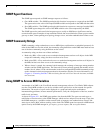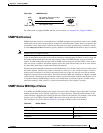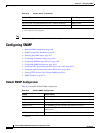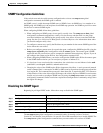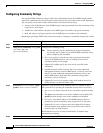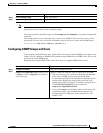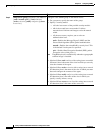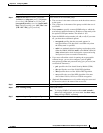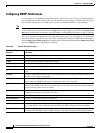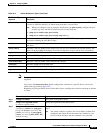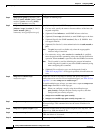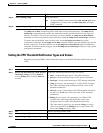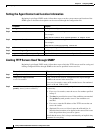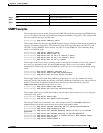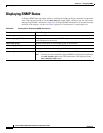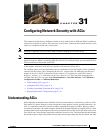
30-12
Catalyst 2960 and 2960-S Switch Software Configuration Guide
OL-8603-09
Chapter 30 Configuring SNMP
Configuring SNMP
Configuring SNMP Notifications
A trap manager is a management station that receives and processes traps. Traps are system alerts that
the switch generates when certain events occur. By default, no trap manager is defined, and no traps are
sent. Switches running this Cisco IOS release can have an unlimited number of trap managers.
Note Many commands use the word traps in the command syntax. Unless there is an option in the command
to select either traps or informs, the keyword traps refers to traps, informs, or both. Use the snmp-server
host global configuration command to specify whether to send SNMP notifications as traps or informs.
Table 30-5 describes the supported switch traps (notification types). You can enable any or all of these
traps and configure a trap manager to receive them. To enable the sending of SNMP inform notifications,
use the snmp-server enable traps global configuration command combined with the snmp-server host
host-addr informs global configuration command.
Table 30-5 Switch Notification Types
Notification Type
Keyword Description
bridge Generates STP bridge MIB traps.
cluster Generates a trap when the cluster configuration changes.
config Generates a trap for SNMP configuration changes.
copy-config Generates a trap for SNMP copy configuration changes.
entity Generates a trap for SNMP entity changes.
cpu threshold Allow CPU-related traps. This trap is supported only when the switch is running the LAN Base
image.
envmon Generates environmental monitor traps. You can enable any or all of these environmental traps: fan,
shutdown, status, supply, temperature.
errdisable Generates a trap for a port VLAN errdisabled. You can also set a maximum trap rate per minute. The
range is from 0 to 10000; the default is 0, which means there is no rate limit.
flash Generates SNMP FLASH notifications. You can optionally enable notification for flash insertion or
removal, which would cause a trap to be issued whenever a switch in the stack is removed or inserted
(physical removal, power cycle, or reload).
fru-ctrl Generates entity field-replaceable unit (FRU) control traps. In the switch stack, this trap refers to
the insertion or removal of a switch in the stack.
ipmulticast Generates a trap for IP multicast routing changes.
mac-notification Generates a trap for MAC address notifications.
msdp Generates a trap for Multicast Source Discovery Protocol (MSDP) changes.
ospf Generates a trap for Open Shortest Path First (OSPF) changes. You can enable any or all of these
traps: Cisco specific, errors, link-state advertisement, rate limit, retransmit, and state changes.
pim Generates a trap for Protocol-Independent Multicast (PIM) changes. You can enable any or all of
these traps: invalid PIM messages, neighbor changes, and rendezvous point (RP)-mapping changes.



